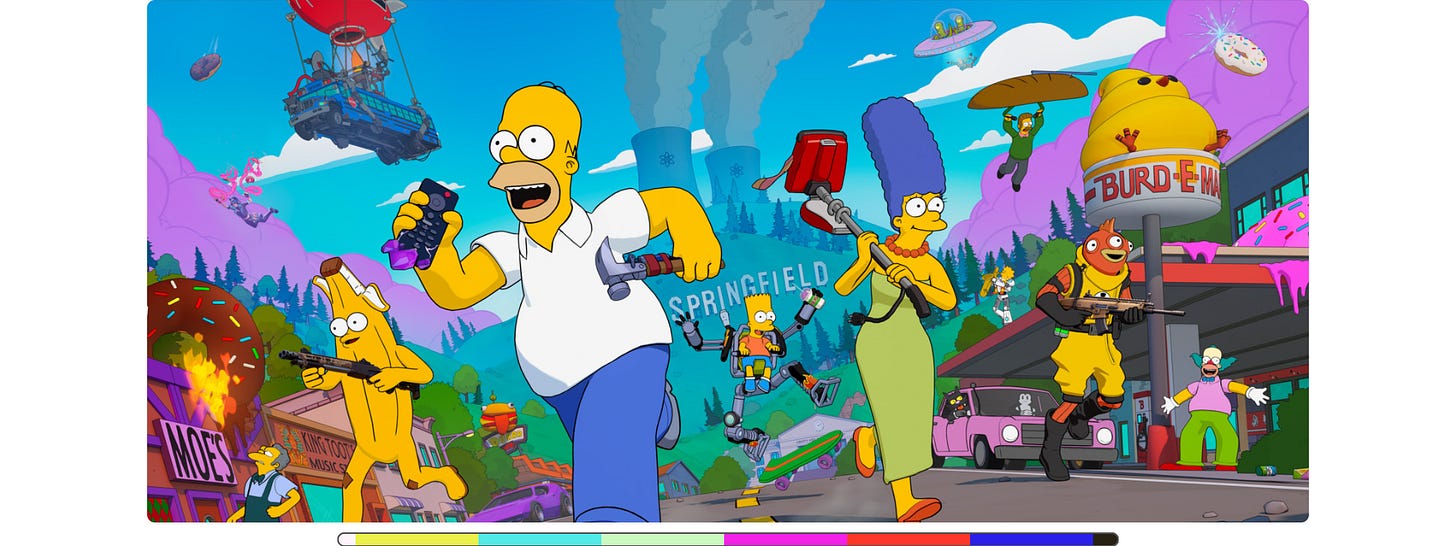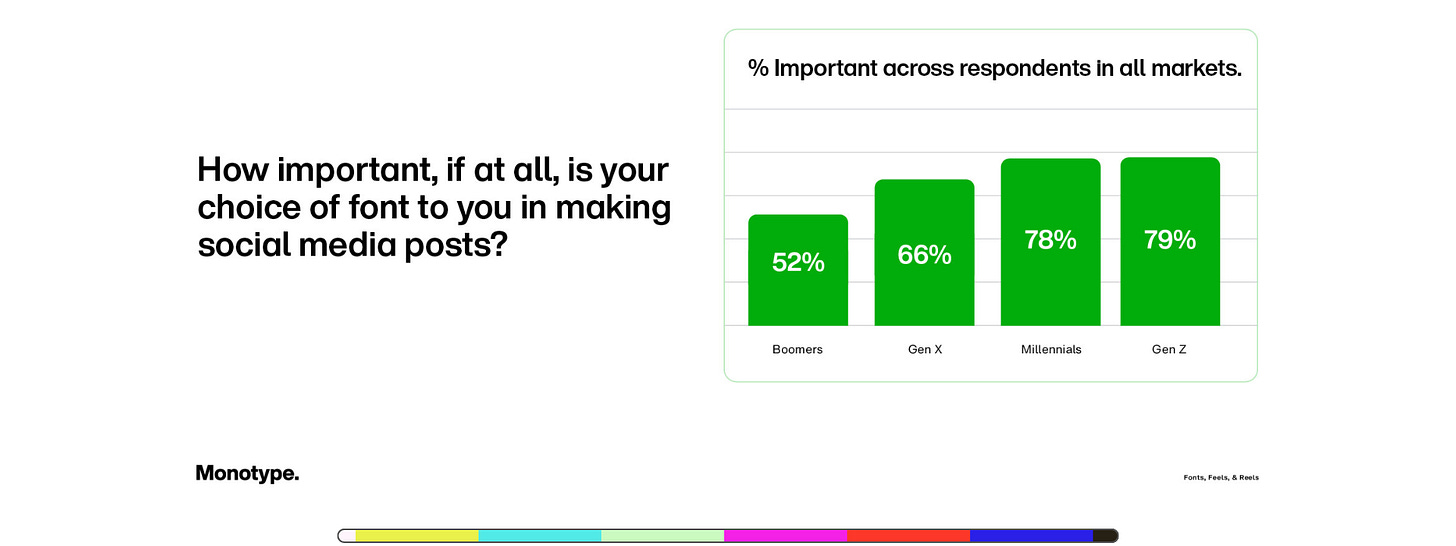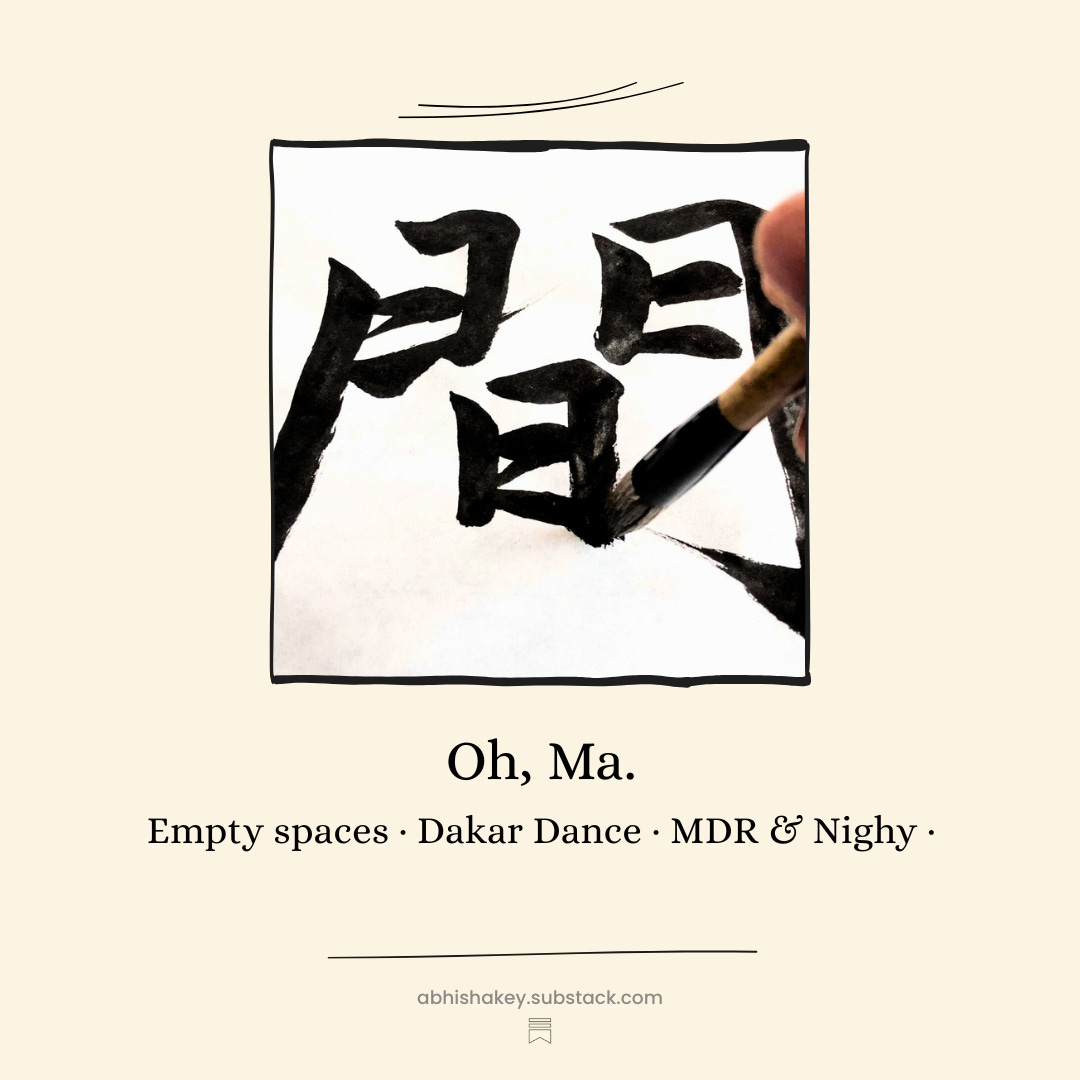Fonts & Farts
· Fartnite! · Fonts matter · AI realities · The end of mass media ·
Welcome The Colour Bar- like a friend in the industry who reads widely, so you don’t have to.
☝🏽Busy? Lazy? Multitasky? Click play above and let me read this to you.
▶️ Curated/Cuts: Its Fartnite! Battle royale comes to Springfield, and an unlikely LLM saviour.
The right type: Fonts matter. Don’t take my word for it.
AI realities: Universal settles for AI music; Pulitzer winners’ & machine learning.
Playlist: the end of mass media.
➕ Trend reports from Netflix & Warner Music, Dorm room voyeurism, AI regulation in India.
🎬 Curated/Cuts.
1. Fartnite!
“Multiple realities have merged in a cynical brand mashup”!
This is a great example of two worlds coming together- Fortnite x Simpsons is the match we never knew we needed! From what you see in this piece- a mix of the creative take on the iconic Simpsons opening, plus the actual gameplay, the two worlds seem to embrace each other really well.
Original, animated ‘The Simpsons’ shorts highlighting new gameplay will air in Fortnite & Disney+ during the month-long ‘season’. Here’s that short of how the island and Springfield realities merged!
I don’t really play Fortnite, and my best Simpsons watching days are probably behind me, but I still dig how the IP has stayed around, maintaining relevance and finding fresh perspectives.
I guess the one thing missing from Springfield was bombastic battle violence.
Now we have it.
2. Merriam’s LLM
Merriam Webster’s is launching a new LLM on Nov 18. In this, their 12th edition, they claim there are no hallucinations, no data centre, no use of water, even no electricity.
Their socials are quite fun too.
The right type.
I like writing. With a pen. On paper. I don’t do it anywhere near as much I’d like, though. The mind has adjusted to the speed of fingers on a keyboard. Enough that nib on paper can feel sluggish. But, I also dabble(d) in calligraphy, so the aesthetic of writing stays relevant to me.
That’s an intro to say that fonts are important. For some, I suspect this is only too obvious- you choose your fonts daily, or have carefully picked your defaults. For others, maybe this is less apparent - your documents are all in Calibri, or Aptos (default Microsoft fonts).
A recent survey found that typography matters to young people. A lot.
‘Fonts, Feels & Reels’ is Monotype’s multi-country survey, with a skew to social media/digital use. They found that fonts were clearly important to all demographics, but were ‘essential’ for Gen Z and Millennials.
About social media, 78% of all respondents reported that using distinctive, well-selected fonts boosts engagement. This belief was highest among Gen Z (87%) and Millennials (86%).
The global study surveyed over 12,000 social media users across six Latin-script markets (Brazil, France, Germany, Spain, the U.K., and the U.S.) and four generations (Boomers, Gen X, Millennials, Gen Z).
*I do wish that touching three continents /six countries wasn’t considered ‘global’, and something like this could be truly representative.
The writers suggest that brands should elevate fonts to core branding, that “Gen Z & Millennials are judging fonts. They shape their perception of authenticity, personality, values, and trust.”
Hey, I’ve been judging font choices for years. Maybe I’m just closer to the Gen Z…vibe.
Settling for AI
Universal Music has reached a settlement with Udio, the generative AI music service. The outcome is that the two will enter into a partnership where Udio for a new product.
For this, Udio will have access to UMG’s catalog- only with artists who opt-in. Users on this platform will be able to remix, reuse and generate AI outputs. But crucially- this will be a walled-garden, You can listen to these ‘reimagined, re-somethinged’ tracks only on this platform. They can’t be exported or downloaded and will not be flooding our streaming services. Now- this is good for artists, of course. But surely, it raises some fundamental questions for Udio and other such services like Suno (who are all in court), because a platform-play is suddenly less powerful.
Just as well. As so many are wondering, who needs this anyway?
Also, this is sounds pretty much like the Sora app, exclusively for AI generated video content. With that parallel, are these just testing grounds for consumer products, or a pathway for Generative AI to find wider acceptance and use?
This op-ed from Ed Newton-Rex breaks it down nicely.
Reporting with AI
How Pulitzer winners used AI in their reporting came out some time back, but was lost in my bookmarks. Generative AI tools were not, shall we say, well-represented among these AI disclosures. Reporters primarily used machine learning techniques that preceded the release large language models (LLMs).
“The most important reporting method, by far, was human reporters reading and extracting information from the documents.”
WSJ: models to visualise how Elon Musk’s 41K X posts shifted from business to politics.
“40 Acres and a Lie”: Custom image recognition to read handwritten records from 1800s, in a genealogical deep dive into land allocated to—and then stolen from—formerly enslaved Black Americans.
Washington Post: Gaza investigation: geospatial AI to analyze satellite imagery.
AP: OCR and speech recognition to process 200k+ documents and build national database of police killings
The future of AI in journalism isn’t going to be ChatGPT writing articles. It’s going to be expert journalists using specialized AI tools to uncover stories that were previously impossible to tell. _Florent Daudens
from Niemen Journalism Lab, by Andrew Deck
Playlist
Peter Kafka’s podcast Channels often has insightful, plain-speaking chats at the intersection of media & tech. He recently spoke with Brian Morrissey, who runs The Rebooting, where he podcasts, writes and hosts events- all geared at people in the media business.
It was a good chat to look at the place of small media from “a guy who understands the big picture, but also the practical realities of operating.“
There is an irony that we always hear about trust in media being at some new low and at some point it will bottom out, and it’ll start to normalize. But then at the same time, all these AI answer bots are known for their hallucinations, it’s just making stuff up.
But like, the trust issues seem to fall to mainstream media.
➕
Netfix Ads released ‘Still Watching’, a report on streaming audiences, targeted to marketers and advertisers. Pushing their ad-supported tier, the report emphasizes how streaming is shaping culture, fandom, and the future of brand engagement.
Warmer Music released a report on music insights and trends of 2025. Titled “Music is an Essential Tool”, it is targeted at brands & filmmakers. Notable themes include Analog Footage, Dance Integration, One shot takes, and tech free lifestyles.
In a thought-provoking piece titled, “From Dorm Room to Default - How Voyeurism Became a Business Model”, Christine Haskell, Ph.D. looks through the lens of Meta’s recently released glasses to urge leaders to take on the privacy challenges it brings.
“Harms don’t need villains; they require unquestioned defaults. In a system where attention is rewarded, safety drifts into “feature,” not floor—and families, schools, and workers sit on the wrong side of the information asymmetry. In that world, relying on corporate virtue is malpractice.”OpenAI released their ChatGPT-powered web browser ‘Atlas’ recently (and Microsoft followed with their own soon after). A couple of underwhelmed takes- unsure why we quite need this:
“Atlas is little more than cynicism masquerading as software.“ ^
“moderately helpful at best. Sometimes, it’s confusingly wrong.” ^Proposed AI-related regulation in India expectedly prompted much chatter. Nikhil Pahwa raises questions around both the practical viability and technological disincentives such regulation might cause.
These are worthy discussion points. Yet there is the (already slightly tired) ‘regulation is anti- innovation’ thought. And despite outlining the “very real” harms that generative AI in particular can cause, the piece offers little in terms of a practical path ahead.
Ma.
A universal sound. Across the continents, it has gathered a surprisingly wide range of meanings: mother, space, numbness, scolding, respect, a question, a ghost, a pause. In Coffee & Conversations, I explored this word beyond its near-universal maternal connotations. Most fascinatingly in Japan, where “ma” becomes something else entirely- teaching us to savour what can’t be said at all.
Its a story that traverses space, spice, architecture, anime and manga. Go on, have a look.











